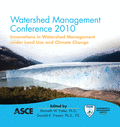Fish Passage Restoration and the NEPA Process: Balancing Environmental Considerations with Historical and Cultural Resources
Publication: Watershed Management 2010: Innovations in Watershed Management under Land Use and Climate Change
Abstract
Restoration of fish passage along our rivers and streams can improve the overall aquatic habitat and environmental conditions of our waterways by allowing migration and spawning of species currently blocked by dams. Fish passage can enhance the overall productivity of ecosystems by enabling anadromous fish to return to their previous spawning grounds. This, in turn, increases the system's food supply web for resident and migratory fish. Perhaps the most effective method of restoring fish passage is to remove the stream impediment and restore the channel to natural conditions. However, existing conditions such as the historical and cultural aspects of the dam, the chemical composition of built-up sediment behind the dam, and the potential for increased downstream flood hazard risk may influence the selection of a recommended plan. Restoring environmental balance to our nation's rivers may affect historic structures and archaeological sites. This can trigger state and federal historic preservation laws, and interest in preserving a piece of local history, as well as providing an opportunity for historic discovery (McClain, et al., 2008). So, how do you determine the best method of restoring fish passage for your project? Congress passed the National Environmental Policy Act (NEPA), Public Law (P.L.) 91–190 in 1970 to establish a national policy for the protection and maintenance of the environment. The law provided a process all federal agencies must follow in evaluating the potential impacts a project has on the environment. Following the NEPA process leads to the publication of an Environmental Assessment which contains a compilation of available data regarding the project, including public comments, that allows decision makers to make educated and informed decisions. This paper addresses the National Environmental Policy Act (NEPA) and how it served as the decision document in determining the best alternative to restore fish passage at the Woodland Dam. Specifically, the paper will address environmental considerations typical of urban streams and the historical considerations associated with modifying a dam originally constructed in the 1640's. Emphasis will be placed on the interagency coordination between the U.S. Army Corps of Engineers (Corps), the Pennsylvania Department of Environmental Protection (PaDEP) and the Pennsylvania Historical & Museum Commission (PHMC). We will focus on how issues are resolved concerning environmental benefits and impacts balanced against maintaining our historical and cultural resources.
Get full access to this article
View all available purchase options and get full access to this chapter.
Information & Authors
Information
Published In
Copyright
© 2010 American Society of Civil Engineers.
History
Published online: Apr 26, 2012
ASCE Technical Topics:
- Architectural engineering
- Building management
- Business management
- Construction engineering
- Construction management
- Dams
- Ecological restoration
- Ecosystems
- Environmental engineering
- Federal government
- Fish and fishery management
- Geotechnical engineering
- Government
- Historic preservation
- Historic sites
- History and Heritage
- Organizations
- Practice and Profession
- Project management
- River engineering
- Rivers and streams
- Water and water resources
Authors
Metrics & Citations
Metrics
Citations
Download citation
If you have the appropriate software installed, you can download article citation data to the citation manager of your choice. Simply select your manager software from the list below and click Download.
